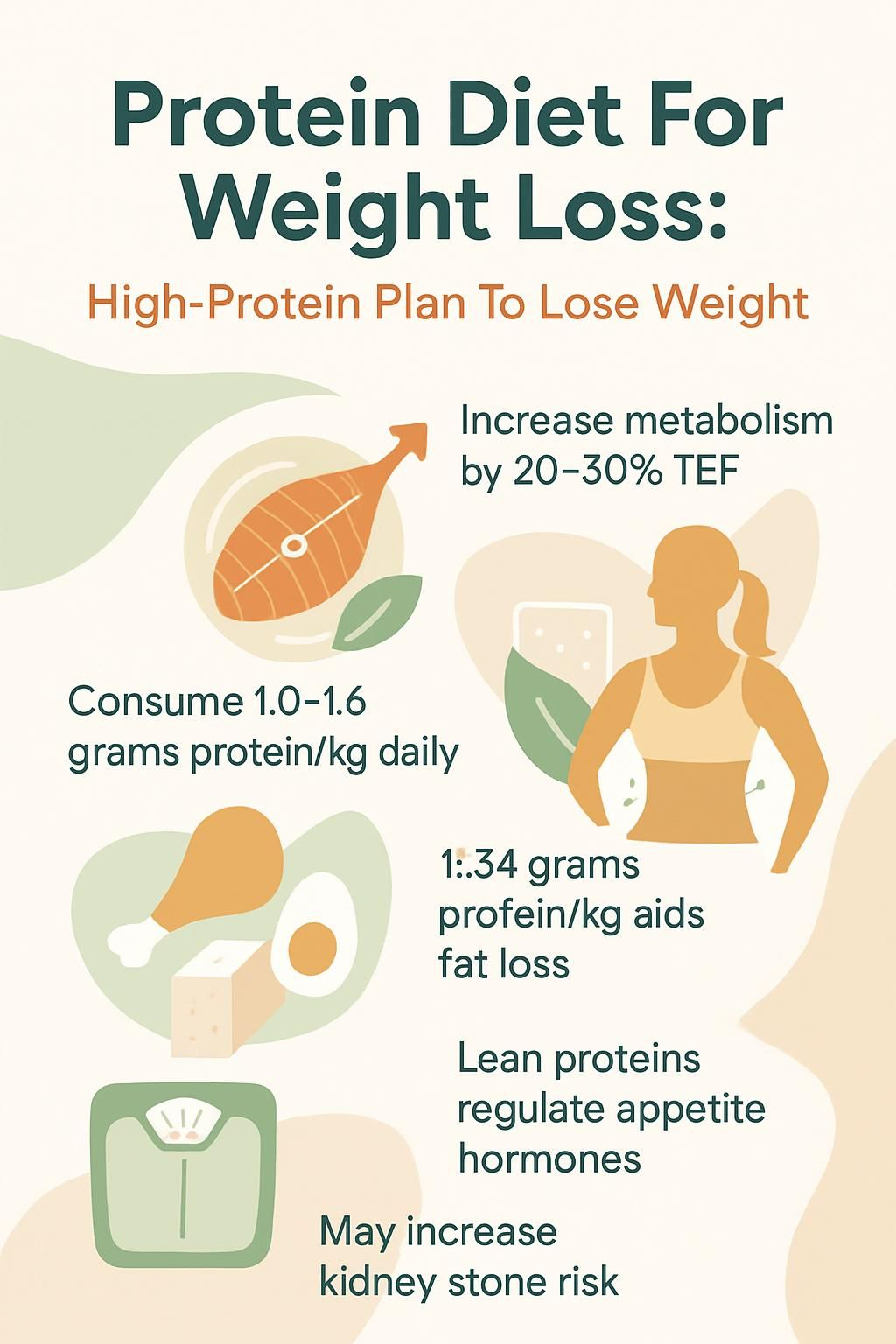Protein Diet For Weight Loss: High-Protein Plan To Lose Weight
Our Nutrition Assistant AI Suite will transform your body. You will lose fat, get toned, and build muscle. Gain confidence and optimal health.
You may find it hard to lose weight or keep hunger steady with your current routine. A high-protein diet for weight loss can help you feel full longer and burn a few more calories after meals.
This guide explains how high-protein foods support fat loss, protect muscle, and curb appetite. You will see simple steps, clear targets, and food ideas you can use today.
Key Takeaways
- Protein has a higher thermic effect of food, about 20–30 percent, compared with carbohydrates at 5–10 percent and fats at 0–3 percent. You burn more calories processing protein.
- For weight loss, many experts suggest 1.0 to 1.6 grams of protein per kilogram per day. This helps preserve muscle and may lower the chance of regaining fat.
- Research from 2017 found that at least 1.34 grams per kilogram led to greater fat loss over six months than the standard RDA intake.
- Lean meats, eggs, fish, legumes, and low-fat dairy can boost satiety hormones such as PYY and GLP-1 and may reduce ghrelin, a hunger hormone.
- High-protein diets are not right for everyone. If you have kidney disease or a history of kidney stones, seek medical advice first and include plenty of fiber-rich foods.

Why Protein Is Key to Losing Weight

Protein is a key nutrient in many diets for weight loss and for general health. Think of it as the anchor that helps steady your plan while the scale moves.
How does protein boost metabolism?
Eating more protein raises the energy your body spends on digestion. This process is called the thermic effect of food, or TEF. For protein, TEF is about 20 to 30 percent. For carbohydrates it is about 5 to 10 percent, and for fats it is roughly 0 to 3 percent.
You burn more calories breaking down protein than carbs or fats. That extra burn happens after meals and even during sleep. Higher protein also protects lean muscle, which helps keep your basal metabolic rate, or BMR, from dropping while you diet. In a 2017 trial, people eating around 1.34 grams per kilogram lost more weight over six months than those at the minimum RDA level [1].
A higher protein intake raises daily energy expenditure through a greater thermic effect than other macronutrients.
Add protein to each meal to tap this metabolic edge, then build the rest of your plate with produce and whole grains.
How does protein affect appetite and fullness?
Protein prompts satiety hormones such as PYY and GLP-1 to rise. At the same time, it may lower ghrelin, the hormone that triggers hunger. For example, three ounces of skinless chicken breast provide about 26 grams of protein and can increase fullness.
Spreading protein across four or five meals or snacks helps keep you satisfied. Pair protein with fiber-rich carbohydrates like fruit, beans, and whole grains to stretch fullness even longer. Many people notice that a breakfast with Greek yogurt keeps them full until lunch more than a sugary cereal.
Why is protein important for preserving muscle?
During a weight-loss diet, you risk losing muscle if you eat too little protein. Protein supplies amino acids that repair and maintain muscles, bones, and skin every day.
Higher protein diets support muscle retention, which keeps metabolism steadier while you lose fat. A 2016 review suggests up to 2 grams per kilogram can help prevent muscle loss during dieting or hard training. Women over 65 may need at least 1.3 grams per kilogram to limit age-related muscle decline, called sarcopenia.
Choose a mix of animal and plant protein sources, like poultry, fish, beans, and tofu. This approach makes it easier to protect lean mass while improving body composition.
How Protein Helps You Lose Weight
Protein supports weight loss in several ways. It raises calorie burn, improves fullness, and often leads to lower calorie intake without strict food rules.
How does protein increase calorie burn during digestion?
Protein has a strong thermic effect of food. You spend about 20 to 30 calories digesting every 100 calories of protein. Carbohydrates require only 5 to 10 calories per 100, and fats require 0 to 3 calories per 100.
This raises daily energy expenditure and can speed fat loss while protecting lean mass. Some people even feel a slight warmth after eating high-protein meals. Studies show higher calorie burn after meals on a high protein diet compared with lower protein plans.
High-protein diets can increase total daily calorie burn thanks to a higher thermic effect.
Using eggs, seafood, or beans as your protein source gives you this advantage with familiar foods.
How does protein keep you feeling full longer?
Protein boosts satiety hormones and tamps down hunger signals. Adding protein to each meal can keep cravings quiet for hours. A half-cup of low-fat cottage cheese gives 12.4 grams of protein and helps control appetite between meals.
Pair protein with fiber, such as lentils or whole grains, to increase staying power. Many people see fewer afternoon snacks after a protein-rich breakfast.
How does protein help reduce calorie intake?
Feeling full longer means less snacking and smaller portions without forcing it. Replacing refined carbs with protein foods like chicken, lentils, or yogurt often lowers calories across the day.
Some follow the 90-30-50 method, which targets roughly 90 grams of protein, at least 30 grams of fiber, and about 50 grams of healthy fats per day. Eating protein at four or five eating times also helps control hunger better than one or two large meals.
What Is the Recommended Protein Intake for Weight Loss?
You need enough protein each day to support weight loss, muscle health, and a balanced diet, so setting a clear target helps.
How much protein do you need daily to lose weight?
To boost weight loss, aim above the standard RDA of 0.8 grams per kilogram, or 0.36 grams per pound. Many high-protein diet plans suggest 1.0 to 1.6 grams per kilogram per day.
For example, if you weigh 150 pounds, about 68 kilograms, try 82 to 136 grams of protein daily. A 2017 study found that at least 1.34 grams per kilogram led to greater fat loss over six months than the minimum guideline [1]. If you weigh 175 pounds, a practical target is roughly 80 to 100 grams per day for satiety and muscle retention [2].
These ranges help keep you full and support energy balance while you cut calories.
How do you balance protein with other nutrients?
After you set your daily protein goal, build a balanced plate. The National Academy of Medicine suggests 10 to 35 percent of calories from protein. Carbohydrates should provide 45 to 65 percent, and fats around 25 to 35 percent.
Choose fiber-rich carbs like fruit, vegetables, whole grains, beans, and low-fat dairy. For fats, pick nuts, seeds, olives, olive oil, canola oil, avocado, and fish such as salmon or sardines. One simple plan is the 90-30-50 method, which focuses on protein, fiber, and healthy fats each day.
Here is a quick guide to daily calorie breakdown.
| Nutrient | Percentage Range |
| Protein | 10–35% |
| Carbohydrates | 45–65% |
| Fats | 25–35% |
Mix animal proteins such as poultry or seafood with plant proteins like tofu or lentils. This supports muscle during weight loss and helps protect heart and blood sugar health.
Best High-Protein Foods to Support Weight Loss
Choosing the right protein foods makes your plan easier to stick with. Simple swaps build meals that are filling, steady, and flavorful.
What lean meats and poultry are best?
Skinless chicken breast and skinless turkey are top choices. A 3-ounce serving of cooked chicken breast gives about 26 grams of protein with little fat. Lean cuts of beef or pork labeled loin or round can also fit well.
Include these proteins in your meals to stay full and protect muscle while losing fat. Skip processed meats like sausage and bacon to reduce saturated fat and sodium.
Which fish and seafood are high in protein?
Salmon, tuna, and cod offer solid protein, plus omega-3 fats in salmon. Most 3-ounce portions of fish provide 17 to 20 grams of protein. Shrimp and whitefish give a lean, low-calorie option.
Try seafood two or three times per week to get a range of nutrients. Grilled salmon or tuna on a salad can keep lunch satisfying without many calories.
Are eggs and dairy good protein sources?
Eggs and dairy are convenient and versatile. One large egg supplies 6 grams of protein. Low-fat dairy, such as yogurt, cottage cheese, and milk, adds high-quality protein with calcium.
For example, 4 ounces of plain low-fat yogurt have about 6 grams, and a half-cup of low-fat cottage cheese has 12.4 grams. Choose low-fat options if you are watching saturated fat or LDL cholesterol.
What plant-based proteins like beans and tofu work well?
Beans, lentils, tofu, tempeh, and nut butters provide protein plus fiber. A half-cup of cooked lentils gives 9 grams of protein, and the same amount of kidney beans gives about 7.7 grams. Firm tofu has around 9 grams per 3 ounces.
Almonds and peanut butter also help. One ounce of almonds has 6 grams of protein, and two tablespoons of peanut butter provide about 7 grams. These foods help curb appetite and fit well in vegetarian and vegan plans.
What Does a Sample High-Protein Meal Plan Look Like?
A sample plan shows how to place protein across your day. You can keep meals simple and repeat your favorites.
What are some high-protein breakfast ideas?
A protein-rich breakfast can steady hunger and energy for hours.
- Scrambled eggs, 6 grams per large egg. Add beans or nuts for extra protein and fiber.
- Greek yogurt, about 6 grams per 4 ounces. Mix with berries or walnuts for a balanced bowl.
- Low-fat cottage cheese, 12.4 grams per half-cup. Top with fruit or cinnamon.
- Protein pancakes made with whey or plant protein. This boosts amino acids that support muscles.
- Protein smoothie with milk or a dairy alternative and a scoop of protein powder. Add nut butter for healthy fats.
- Breakfast burrito with eggs, black beans, and turkey or chicken. High in protein and fiber for lasting energy.
- Oatmeal stirred with protein powder. More filling than oats alone.
Starting strong at breakfast makes it easier to manage cravings later in the day.
What are good high-protein lunch options?
Lunch should keep you satisfied through the afternoon and support your calorie goals.
- Grilled chicken breast, 26 grams per 3 ounces, low in fat.
- Lentil salad, about 9 grams per half-cup, high in fiber to aid digestion.
- Firm tofu, 9 grams per 3 ounces, easy to season and sear.
- Tuna or salmon salad, about 20 to 24 grams per serving, with heart-healthy fats.
- Mixed greens with low-fat cottage cheese or Greek yogurt, typically 12 to 18 grams added.
- Lean turkey with beans, a combo that raises protein and fiber.
- Pair with whole grains like quinoa or brown rice for steady energy.
After a few protein-focused lunches, many people notice fewer snack cravings later in the day.
What dinner suggestions are rich in protein?
Dinner is a great time to raise your protein intake and still keep balance on the plate.
- Baked salmon, 17–20 grams per 3-ounce cooked portion, rich in omega-3 fats.
- Lean steak cuts like sirloin or tenderloin, about 22 grams per 3 ounces, with less saturated fat than fattier cuts.
- Skinless turkey breast, around 25 grams per 3 ounces, supports muscle preservation.
- Bean-based stews, 13–18 grams per cup, with fiber for fullness.
- Tofu or tempeh, 10–15 grams per half-cup, a good plant option for any table.
- Nuts or seeds on vegetables, about 5 grams per 2 tablespoons, for extra crunch and protein.
- Build balanced plates with vegetables and whole grains to meet nutrient needs while controlling calories.
Rotate your proteins through the week to keep dinner interesting and nutritious.
What are healthy high-protein snacks?
Smart snacks help you bridge the gap between meals. Aim for low added sugar and modest saturated fat.
- Almonds, 1 ounce with 6 grams of protein, also provide healthy fats, based on United States Department of Agriculture data.
- Boiled eggs, about 6 grams each, portable and filling.
- Low-fat Greek yogurt, about 15 grams per 6 ounces, rich in calcium.
- Protein bars or shakes for convenience. Choose low sugar options with solid protein.
- Two tablespoons of peanut or almond butter, about 7 or 6.7 grams, on whole grain crackers or apple slices.
- Hummus with raw vegetables. Beans offer protein and fiber in a simple dip.
- Cottage cheese with fruit, about 12 grams per half-cup, especially if you choose low-fat versions.
These choices travel well and can reduce extra calories by keeping you satisfied.
How Can You Increase Your Protein Intake?
Small changes add up. A few routine swaps can help you hit your protein goal without extra stress.
How do you add protein to every meal?
Use these simple ideas to boost protein from morning to night.
- Start with eggs at breakfast. Two eggs give about 12 grams and keep you full.
- Choose low-fat cottage cheese or Greek yogurt. A half-cup of cottage cheese gives 12.4 grams.
- Add skinless chicken breast to salads or wraps. Three ounces have 26 grams.
- Include lentils in soups or bowls. A half-cup has 9 grams.
- Spread peanut butter on whole-wheat toast, 7 grams in two tablespoons.
- Use tofu, beans, or chickpeas in stir-fries and salads for plant protein.
- Eat fish such as salmon or canned tuna twice a week for protein and heart health.
- Track your intake with a food app to ensure you reach your goal.
- Snack on nuts, seeds, or a stick of low-fat cheese for an easy protein bump.
Plan your day around a protein source first, then add fiber-rich sides and healthy fats.
When and how should you use protein supplements?
If you struggle to reach 70 to 100 grams of protein per day with food, a supplement can help. A shake works well at breakfast or right after a workout, when your body uses amino acids to repair muscle.
Pick a powder that is low in added sugar and saturated fat. Drink enough water during higher protein intake to reduce dehydration risk. Speak with a dietitian or clinician if you have kidney disease or high blood pressure before using supplements.
Use shakes for convenience on busy days, but keep whole foods as your base for vitamins, minerals, and fiber.
What are easy ways to prepare protein-rich meals?
Cooking high-protein meals can be simple with a few techniques.
- Grill, bake, or broil lean meats and fish to keep flavor high and fat low.
- Make bean salads, lentil soups, or tofu stir-fries for quick plant protein.
- Top oatmeal, yogurt, or salads with nuts and seeds for crunch and protein.
- Prep egg muffins or protein pancakes to speed up weekday breakfasts.
- Batch-cook chicken, fish, or beans for fast lunches and dinners.
- Add low-fat Greek yogurt or cottage cheese to snacks and sides.
- Plan weekly menus so protein shows up at every meal.
- Combine proteins for balance, like eggs with spinach or beans with rice.
- Use sheet-pan roasting and quick marinades to save time and boost taste.
Are High-Protein Diets Safe for Everyone?
High-protein diets that limit carbohydrates may not fit every health situation. Talk with a healthcare professional before major diet changes, especially if you have kidney or metabolic conditions.
What are the potential risks of high-protein diets?
Large amounts of protein without enough fiber can lead to bad breath, headaches, and constipation. Diets high in saturated fat from fatty meats may raise LDL cholesterol and heart disease risk.
A 2022 meta-analysis linked higher nondairy animal proteins, like red meat and poultry, with a greater risk of kidney stones. Extra protein can strain the kidneys, especially in people with kidney disease, diabetes, or high blood pressure. Skipping fruits and whole grains can also leave gaps in vitamins and minerals.
Too little protein can be harmful too, leading to swelling, mood changes, weakness, and fatigue. Find a middle ground that fits your health, activity level, and goals.
Work with a clinician if you have medical concerns. Safety comes first.
How can you manage long-term high-protein eating safely?
Check with your doctor before raising protein, particularly if you have kidney issues. Track your food to stay balanced. Get plenty of fiber from fruits, vegetables, and whole grains to prevent constipation on lower carb plans.
Drink water throughout the day. Choose quality protein such as chicken breast, fish, eggs, beans, tofu, and low-fat dairy. Spread protein evenly across meals to support metabolism and muscle maintenance.
Many people do best with a structured plan made with a registered dietitian who can tailor the approach to your needs.
What Are the Benefits of High-Protein Diets Beyond Weight Loss?
Higher protein intake can help in other areas of health. These benefits matter for energy, aging, and daily performance.
How does protein improve muscle strength and recovery?
Protein supplies amino acids for muscle repair after exercise. This process, called protein synthesis, fixes tiny muscle tears and supports strength.
Older adults often need more. Studies suggest women over 65 may benefit from about 1.3 grams per kilogram to limit muscle loss. Lean meats, dairy, and beans work well in post-workout meals and can reduce soreness.
Can protein help control blood sugar better?
Protein slows the digestion of carbs, so sugar enters your blood more gradually. This can reduce spikes in blood sugar and help control cravings.
Plant proteins like beans, lentils, and tofu have a lower glycemic effect than refined carbs. Include a protein source at each meal to promote steady energy.
Does protein support stronger bone health?
Protein helps build and maintain bone tissue. Higher protein intake is linked with stronger bones and a lower risk of osteoporosis in older adults.
Combine protein with calcium and vitamin D from foods like low-fat dairy and leafy greens. Both animal and plant proteins can help preserve bone density as part of a balanced diet.
What Are Common Myths About High-Protein Diets?
Some claims about protein do not match the evidence. Clearing them up can help you choose foods with confidence.
Is protein bad for kidney health?
For most healthy adults, research does not show kidney harm from higher protein diets. A 2019 review found no link between higher protein intake and kidney problems in healthy people.
If you have kidney disease, your doctor may set a lower protein target. A 2022 review noted that nondairy animal proteins might raise kidney stone risk. Dairy proteins may be linked with lower stone risk. Work with your clinician if you have a history of stones or kidney issues.
Here is a simple overview.
| Diet Type | Effect on Healthy Kidneys | Effect if Kidney Disease Exists |
| Higher protein intake | No harm shown in 2019 review | May require restriction and monitoring |
| Animal or meat proteins | Slightly higher stone risk | Needs clinician supervision |
| Dairy proteins | Lower stone risk | Often safer, but still monitor |
Most people do well with balanced protein as part of a healthy diet. If you have kidney concerns, get medical advice before making changes.
Does protein affect heart health?
Protein affects heart health based on the source. Lean animal proteins like skinless chicken and turkey offer high-quality protein with less saturated fat. Too much fatty red meat and processed meat can raise LDL, or bad cholesterol, which increases heart disease risk.
Plant proteins like beans, nuts, and soy tend to support better cholesterol numbers. Replacing some animal protein with plant protein each week can help protect blood vessels while you lose weight.
FAQs on High-Protein Diets for Weight Loss
You may still have questions. These quick answers can help you take the next step.
How much protein is too much?
Most healthy adults do not need more than 1.6 grams per kilogram, 0.7 grams per pound, per day for weight loss or muscle maintenance. A 2013 study found little added benefit above 2 grams per kilogram, 0.9 grams per pound, and risks can rise for some people. The National Academy of Medicine advises keeping protein within 10 to 35 percent of total calories.
Very high intake can raise the risk of dehydration or constipation unless you drink water and eat fiber. If you have kidney issues, speak with your healthcare provider about a safe limit.
Can you lose weight without exercising?
You can lose weight without exercise by following a high-protein diet and a calorie deficit. Studies show higher protein increases fullness and helps preserve muscle, which keeps metabolism steadier.
Foods like chicken breast, Greek yogurt, eggs, and beans can help. Many people feel satisfied longer when they swap a refined carb breakfast for eggs or cottage cheese.
What are the best protein sources for vegetarians?
Soy products are a strong base. Three ounces of firm tofu have about 9 grams of protein. Tempeh and soy curls are also rich in protein.
Beans and legumes provide essential amino acids. A half-cup of cooked lentils gives about 9 grams, and kidney beans about 7.7 grams. Nuts, nut butters, seeds, quinoa, and other whole grains make it easier to reach your daily goal.
Conclusion
A protein diet for weight loss helps tame hunger, protect muscle, and support steady fat loss. Lean meats, fish, eggs, beans, and low-fat dairy are dependable protein foods that fit a healthy diet.
Balance your plate with vegetables, whole grains, and healthy fats. Set a clear protein target, then spread it across the day. If you have medical conditions or plan to use supplements, talk with a healthcare professional first.
Choose a high-protein diet that feels sustainable. With consistent habits and smart food choices, you can lose weight and keep it off.
[1] Randomized controlled trials on higher protein intake and fat loss. [2] Meta-analyses on optimal protein needs for adults seeking fat loss.
FAQs
1. What is a protein diet for weight loss?
A protein-focused eating plan increases the share of foods like poultry, seafood, eggs, and dairy in daily meals. This approach helps people feel full longer and supports muscle maintenance during calorie reduction.
2. How does a high-protein plan help with losing weight?
Eating more protein can reduce hunger by increasing satiety hormones and lowering levels of appetite-stimulating hormones. Studies show that higher protein intake may boost metabolism slightly; one review found that people on high-protein diets lost about 1 to 2 pounds more over twelve weeks compared to those on standard diets (Leidy et al., 2015).
3. Are there risks linked to following a high-protein meal plan?
Most healthy adults tolerate increased protein well if they drink enough water and balance their nutrient intake. However, individuals with kidney disease or certain metabolic conditions should consult healthcare professionals before starting this type of regimen.
4. Can you give an example of how someone might use a high-protein diet for weight management?
After struggling with late-night cravings, I shifted my evening snack from crackers to Greek yogurt mixed with berries and nuts. This change kept me satisfied until morning while helping me stay within my calorie goals.
Summary: A balanced increase in lean meats, fish products, eggs, or milk-based foods can support weight loss efforts by promoting fullness and preserving muscle mass when paired with proper hydration and medical guidance as needed.







